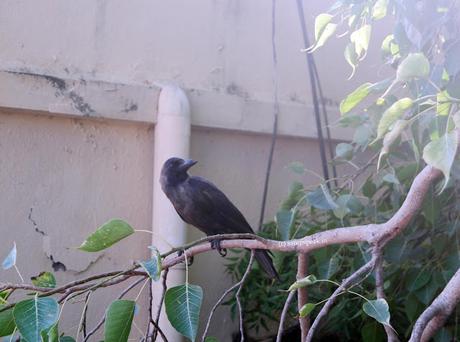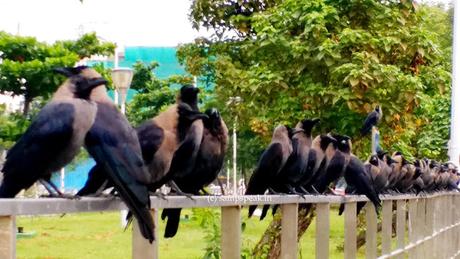கா கா கா!கா கா கா; ஆகாரம் உண்ண எல்லோரும்
ஒன்றாக ! அன்போடு ஓடிவாங்க
-was a song from film Parasakthi, directed by Krishnan Panju and you will see Sivaji Ganesan feeding crows.Like them or not, they are the city birds. If you ask children of Chennai apartments to name 5 birds – it would be ‘4 crows and 1 sparrow (kuruvi)’.

How superstitious are you !~ a few months back, when our students were preparing for their exams, I head them remarking – ‘One for sorrow – two for joy’ on spotting a crow on nearby compound wall.One crow ! ~ for two (plural) it is Crows and what do you call a group of them ? – somehow the word ‘School of crows’ strikes mind!
To call a group – it is collective.Collective nouns are names for a collection or a number of people or things. Words like group, herd, and array are collective noun examples. Remember that nouns are words naming people, animals, places, and things. Collective nouns are in a class all their own.
• Our class took cut the studies and went to see a Cricket match.
• The herd of buffaloes were roaming on the streets [reference to animal and not to the group out there]
• in the significant case, the jury announced the verdict
• IPL 2020CSK team would have bubble
• Pallava’s army defeated Chalukyas.
Getting back, though we tend to spot an odd Kingfisher, Parrots, Pigeons, Cranes and some other birds – most common are the Crows and the ones with darker shade (full black அண்டங்காக்கை) The term corvids - includes crows, magpies and ravens - they're some of the most intelligent animals in the world.But Crows and ravens are not the same.A crow is a bird of the genus Corvus, or more broadly a synonym for all of Corvus.
In our literature, Crows are social birds with tight-knight family structures that roost in huge numbers, so what do you call a group of crows? While most people call a group of birds a flock, crows, in particular, have been known by a number of terms. The most popular of these is known as a murder, but a group of crows can also be called a horde, mob, muster, or parcel.
Remember that in elementary school level, we had a lesson highlighting the intelligence of crows – that water at the jug would be too low.Crow would collect pebbles and keep putting them inside. The water level would raise and crow would quench its thirst.Miles away, in an experiment published in PLOS One, Scientists determined that crows can not only tell the difference between water and sand - they also understand water displacement.The test involved tubes containing water and a treat floating on top out of reach. The crows filled the tubes with enough rocks or other heavy items to bring the food within reach. They were observed snapping twigs from trees, then stripping it of bark and leaves, and fashioned the node into a hook. They then used these tools to probe into small spaces for food.
Crows and ravens, although in the same genus (Corvus) are different birds. (Think of leopards and tigers; both are in the genus Panthera, and are obviously related, but they are quite distinct animals.) The words "crow" and "raven" themselves have little or no real taxonomic meaning.
There is a specific word ‘Venery’ – a special type of Collective nouns that denote group of animals. Although archaic by today's standards, venery can still be used to mean "the practice of hunting." Some of the collective nouns for birds are : aerie of eagles; hedge of herons;herd of swans; host of sparrows; huddle of penguins; kettle of hawks; lamentation of swans; mob of emus; murder of crows; murmuration of starlings; muster of peacocks;ascension of larks ; brood of hens;charm of finches; chattering of chicks
Terms of venery were often based on characteristics people perceived in the animals, not from their intrinsic nature. A "piteousness of doves," for example, refers to the fact that the bird holds a special place in religion.Perhaps Crows lacked PR and got the collective noun ‘murder’ assigned to them or was it the bias of mankind in being unkind to crows !!
Crows are omnivorous scavengers and will eat just about anything — insects, seeds, fruits, eggs, and small animals. Folklore and superstitions further fueled the belief.
It is held scientific that common cuckoo uses a sneaky strategy to raise its babies. A female cuckoo finds a nest built by a bird of a different species, mostly crows, sneaks into the nest, lays an egg and flies away. The crow often accepts the new egg and brings it up !!

"One for Sorrow" is a traditional children's nursery rhyme that was gifted by our colonial cousins. According to an old superstition, the number of magpies seen tells if one will have bad or good luck.:-
One for sorrow, Two for joy, Three for a girl, Four for a boy, Five for silver, Six for gold, Seven for a secret - Never to be told, Eight for a wish, Nine for a kiss, Ten for a bird, Eleven is worse; Twelve for a dastardly curse.In Britain, this has been old belief and in 1780, a note in John Brand's Observations on Popular Antiquities on Lincolnshire has this lyric.A version of the rhyme became familiar to many UK children when it became the theme tune of an ITV children's TV show called Magpie, which ran from 1968 to 1980. The popularity of this version is thought to have displaced the many regional versions that had previously existed.
Interesting !
With regards – S. Sampathkumar
3rd Sept. 2020.

